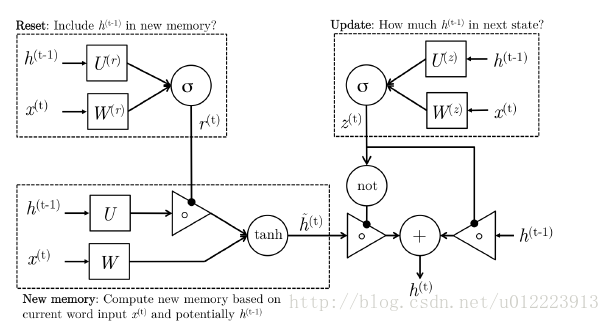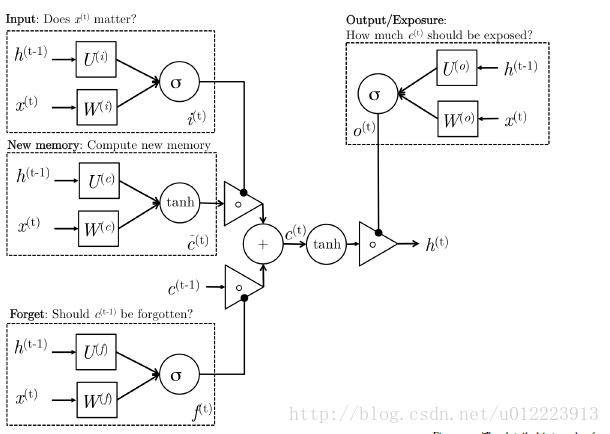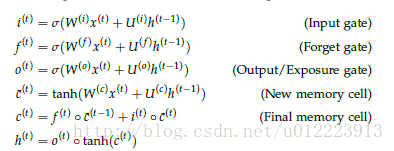First, some conclusions are given
The performance of Gru and LSTM is equal in many tasks. With fewer Gru parameters, it is easier to converge, but LSTM performs better when the data set is large. Structurally, Gru has only two gates (update and reset), LSTM has three gates (forge, input and output). Gru directly transfers the hidden state to the next unit, while LSTM packages the hidden state with memory cell.
1. Basic structure
1.1 GRU

Gru is designed to better capture long-term dependencies. Let’s look at the input first
ht−1
and
x(t)
How can Gru calculate the output
h(t)
:

Reset gate
r(t)
Responsible for decision making
h(t−1)
For new memory
h^(t)
How important is it if
r(t)
If it’s about 0,
h(t−1)
It will not be passed to new memory
h^(t)
new memory
h^(t)
It’s a new input
x(t)
And the hidden state of the previous moment
h(t−1)
The summary of this paper. Calculate the new vector summed up
h^(t)
Contains the above information and new input
x(t)
. Update gate
z(t)
Responsible for deciding how much to pass
ht−1
to
ht
. If
z(t)
If it’s about one,
ht−1
Almost directly copied to
ht
On the contrary, if
z(t)
About 0, new memory
h^(t)
Pass directly to
ht
. Hidden state:
h(t)
from
h(t−1)
and
h^(t)
The weight of the two is determined by update gate
z(t)
Control.
1.2 LSTM

LSTM is also designed to better capture long-term dependencies, but the structure is different and more complex. Let’s take a look at the calculation process:

The new memory cell step is similar to the new memory in Gru. The output vector
c^(t)
It’s all about new input
x(t)
And the hidden state of the previous moment
h(t−1)
The summary of this paper. Input gate
i(t)
Responsible for determining input
x(t)
Whether the information is worth saving. Forget gate
f(t)
Responsible for determining past memory cell
c^(t−1)
yes
c(t)
It’s important. final memory cell
c(t)
from
c^(t−1)
and
c^(t)
The weight is determined by forge gate and input gate respectively. The output gate is not available in Gru. It’s responsible for making decisions
c(t)
Which parts of should be passed to hidden state
h(t)
2. Difference
1. Control of memory
LSTM: controlled by output gate and transmitted to the next unit
Gru: pass it directly to the next unit without any control
2. Input gate and reset gate have different action positions
LSTM: computing new memory
c^(t)
Instead of controlling the information of the previous moment, we use forge gate to achieve this independently
Gru: computing new memory
h^(t)
Reset gate is used to control the information of the previous time.
3. Similar
The biggest similarity is that addition is introduced in the update from t to T-1.
The advantage of this addition is that it can prevent gradient dispersion, so LSTM and Gru are better than RNN.
Reference:
1. https://cs224d.stanford.edu/lecture_ notes/LectureNotes4.pdf
2. Empirical Evaluation of Gated Recurrent Neural Networks on Sequence Modeling
3. https://feature.engineering/difference-between-lstm-and-gru-for-rnns/
Read More:
- NotImplementedError: Cannot convert a symbolic Tensor (LSTM/strided_slice:0) to a numpy array
- Difference between getelementsbyname and getelementbyid
- C#: Analysis of the difference between write() and writeline()
- The difference between problem and observables
- The difference between “?” and “?:” introduced by php7
- The difference between classnotfoundexception and NoClassDefFoundError
- The difference between sleep() and wait() in Java
- The difference of. Pt,. PTH,. Pkl and the way to save the model
- The difference between hive and relational database
- Difference between vs code user and system version
- The difference between onready or $() and onload
- The difference and usage of insmod and modprobe
- The tutorial and difference of glew, glfw, glad and freeglut
- The usage and difference of atoi() and stoi() functions in C + +
- JavaScript summary: the difference between typeof and instanceof, and Object.prototype.toString() method
- Node.js Medium package.json The difference between devdependences and dependencies
- Parsing the difference between “R” and “RB” patterns of text files (Python)
- In C + + cin.getline The difference between () and getline () functions
- The difference of four kinds of integer function (fix floor ceil round) in MATLAB
- The difference, cause and solution of memory overflow and memory leak